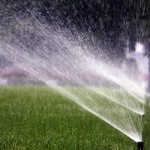Bowling green irrigation or watering is often mis-understood and as a result is often managed insufficiently to ensure that the green performs to its highest standards.
The first thing is to make sure of, is that you are applying enough water every week and that means trying as best you can to keep a record of any rainfall and irrigation that is going onto the green.
Making irrigation management a priority in your bowling green maintenance program is crucial because in a typical dry week your green will lose the equivalent of 25mm of moisture through evaporation from the soil and transpiration from the grass plants ; please remember that this varies considerably around the country and will depend on things like temperature, relative humidity, wind speed and direction, precipitation and of course your bowling green maintenance program.
This means that you should be aiming to get at least that amount back on.
In Performance Bowling Greens, a practical guide I go into detail about Soil Moisture Deficit and how to keep a water balance sheet for the most accurate and efficient way to manage irrigation and that is a really good method to use to get this right.
However, bowling green maintenance at the height of the summer relies a lot on feel for the soil as well and although I would always try to maintain a manageable Soil Moisture Deficit to encourage deeper rooting etc, it is more important right now to get on sufficient water to ensure your green plays consistently and to keep localised dry patch under control or hopefully at bay.
This means you should be aiming to get 25mm of water on in any dry week, making allowances for any rainfall you have had by reducing that amount accordingly.
The most common pump and sprinkler set ups for bowling green maintenance from most of the major irrigation manufacturers will put out approximately 1mm of water for each 2 minutes of system run time.
This means that you need to run the system for 2 minutes per head to replace 1mm of water lost. Remember that is “per head”.
So for a 25mm watering you need to run the system for 50 minutes per head during a 7 day period.
The most effective way to do this is to get this water on in as few applications as possible. Try to aim for 25mm over 3 nights. This is much more effective and makes much better use of precious water than 7 light applications where much of the water is lost to evaporation in the morning.
In my Bowling Green Maintenance book: Performance Greens, a practical guide I go into this subject in quite a bit of detail and lay out a plan that you can use to manage irrigation more effectively.


